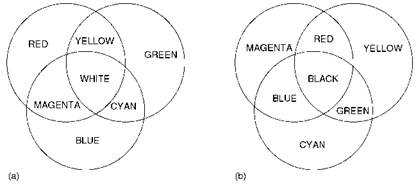Visible light refers to the region of the electromagnetic spectrum to which our eyes are sensitive and corresponds to radiation within the very narrow wavelength range 360-780 nm. Since the sensitivity of the eye to radiation is very low at each of these extremes, in practice the visual spectrum is commonly taken as 380 to 720 nm. Beyond the extremes of this range are the ultraviolet (UV) region of the spectrum (below 360 nm) and the infrared (IR) region (above 780 nm).
Normal white light contains this entire wavelength range, although not necessarily in equal intensities. There are numerous sources of white light, some natural and some artificial in origin. The most familiar natural illumination is daylight, emanating from the sun. The visible light from the sun not only allows us to see objects, but it is in fact essential for life since it is the source of energy responsible for photosynthesis, the vital process which allows plants to grow and thus provides us with an essential food source. Normal daylight encompasses the complete visible wavelength range although its exact composition is extremely variable and dependent on a variety of factors such as the geographical location, the prevailing weather conditions, the time of day and the season. Artificial illuminants, such as the tungsten lamps and fluorescent lights that are used for interior lighting, are also sources nominally of white light, although the composition of the light from these sources varies markedly depending on the type of lamp in question. For example, tungsten lights appear yellowish as the light they emit is deficient in the blue region of the spectrum. Colours do appear different under different illumination sources, although when the human visual system assesses colours it is capable of making some allowance for the nature of the light source, for example by compensating for some of the deficiencies of artificial light.
The splitting of white light into its various component colours is a very familiar phenomenon. It may be achieved in the laboratory, for example, by passing a beam of white light through a glass prism, or naturally, as in a rainbow where the colours are produced by the interaction of sunlight with the raindrops. The visible spectrum is made up of specific wavelength regions that are recognised by the eye in terms of their characteristic colours. The approximate wavelength ranges of light corresponding to these observed colours are given in Table 2.1. Fundamental to the specification of colours is an understanding of the laws of colour mixing, the processes by which two or more colours are combined to ‘synthesise’ new colours. There are two fundamentally different ways in which this may be achieved: additive and subtractive colour mixing. Additive colour mixing, as the name implies, refers to the mixing of
|
Table 2.1 Complementary colour relationships
|
coloured lights, so that the source of illumination is observed directly by the eye. Subtractive colour mixing is involved when colours are observed as a result of reflection from or transmission through an object after it interacts with incident white light. The colours red, green and blue are referred to as the additive primary colours. Their particular significance is that they are colours that cannot be obtained by the mixing of lights of other colours, but they may be combined in appropriate proportions to produce the other colours. As illustrated in Figure 2.1(a), additive mixing of red and blue produces magenta, blue and green gives cyan, while combining red and green additively gives yellow. When all three primaries are mixed in this way, white light is created since the entire visible spectrum is present. A common situation in which additive colour mixing is encountered is in colour television, which uses separate red, green and blue emitting phosphors in the case of traditional cathode-ray tube technology, or using appropriately coloured microfilters in the case of flat-screen displays (see Chapter 10). When an object absorbs light of a given colour corresponding to its particular wavelength range, it is the
|
|
Figure 2.1 (a) Additive colour mixing; (b) subtractive colour mixing complementary colour that is observed. The complementary colour corresponds to the remaining wavelengths of incident light, which are either transmitted or reflected, depending on whether the object is transparent or opaque, and are then detected by the eye. These complementary colour relationships are also given in Table 2.1. For example, an object that absorbs blue light (i. e. in the range 435-480 nm) will appear yellow, because the red and green components are reflected or transmitted. This forms the basis of subtractive colour mixing. This type of colour mixing, which is involved when dyes and pigments are mixed, is the more familiar of the two processes. The subtractive primary colours are yellow, magenta and cyan. These are the colours, for example, of the three printing inks used commonly to produce the vast quantities of multicolour printed material which we encounter in our daily lives, such as in magazines, posters, newspapers, etc. The principles of subtractive colour mixing are illustrated in Figure 2.1(b).
The colours described in Table 2.1 that are observed as a result of this selective light absorption process are referred to as chromatic. If all wavelengths of light are reflected from an object, it appears to the eye as white. If no light is reflected, we recognise it as black. If the object absorbs a constant fraction of the incident light throughout the visible region, it appears grey. White, black and grey are therefore referred to as achromatic since in those cases there is no selective absorption of light involved.
 20 августа, 2015
20 августа, 2015  Pokraskin
Pokraskin 
 Опубликовано в рубрике
Опубликовано в рубрике 